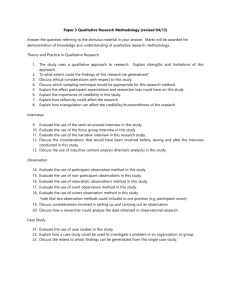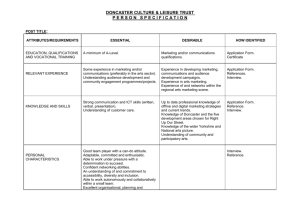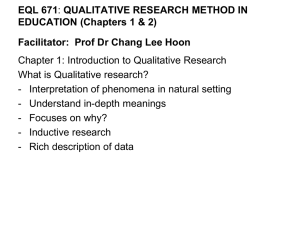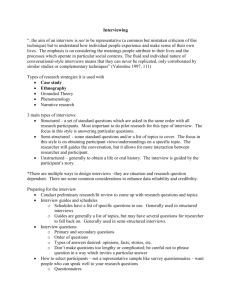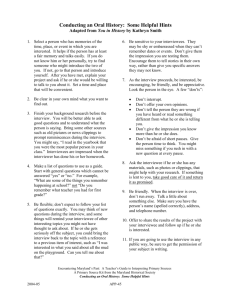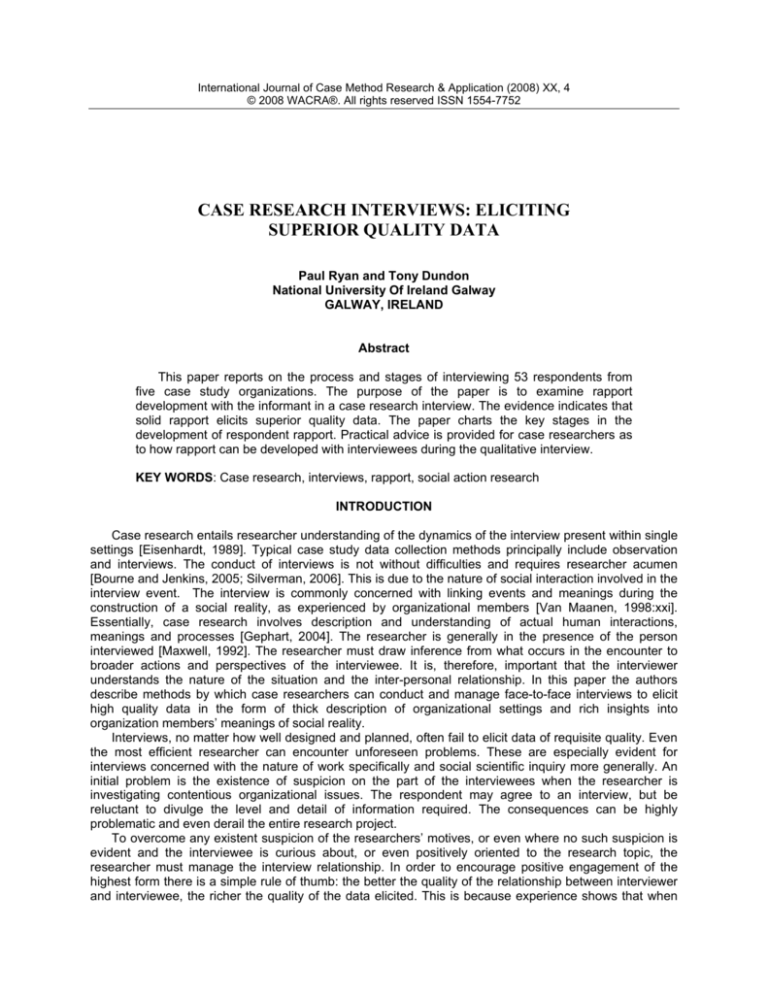
International Journal of Case Method Research & Application (2008) XX, 4
© 2008 WACRA®. All rights reserved ISSN 1554-7752
CASE RESEARCH INTERVIEWS: ELICITING
SUPERIOR QUALITY DATA
Paul Ryan and Tony Dundon
National University Of Ireland Galway
GALWAY, IRELAND
Abstract
This paper reports on the process and stages of interviewing 53 respondents from
five case study organizations. The purpose of the paper is to examine rapport
development with the informant in a case research interview. The evidence indicates that
solid rapport elicits superior quality data. The paper charts the key stages in the
development of respondent rapport. Practical advice is provided for case researchers as
to how rapport can be developed with interviewees during the qualitative interview.
KEY WORDS: Case research, interviews, rapport, social action research
INTRODUCTION
Case research entails researcher understanding of the dynamics of the interview present within single
settings [Eisenhardt, 1989]. Typical case study data collection methods principally include observation
and interviews. The conduct of interviews is not without difficulties and requires researcher acumen
[Bourne and Jenkins, 2005; Silverman, 2006]. This is due to the nature of social interaction involved in the
interview event. The interview is commonly concerned with linking events and meanings during the
construction of a social reality, as experienced by organizational members [Van Maanen, 1998:xxi].
Essentially, case research involves description and understanding of actual human interactions,
meanings and processes [Gephart, 2004]. The researcher is generally in the presence of the person
interviewed [Maxwell, 1992]. The researcher must draw inference from what occurs in the encounter to
broader actions and perspectives of the interviewee. It is, therefore, important that the interviewer
understands the nature of the situation and the inter-personal relationship. In this paper the authors
describe methods by which case researchers can conduct and manage face-to-face interviews to elicit
high quality data in the form of thick description of organizational settings and rich insights into
organization members’ meanings of social reality.
Interviews, no matter how well designed and planned, often fail to elicit data of requisite quality. Even
the most efficient researcher can encounter unforeseen problems. These are especially evident for
interviews concerned with the nature of work specifically and social scientific inquiry more generally. An
initial problem is the existence of suspicion on the part of the interviewees when the researcher is
investigating contentious organizational issues. The respondent may agree to an interview, but be
reluctant to divulge the level and detail of information required. The consequences can be highly
problematic and even derail the entire research project.
To overcome any existent suspicion of the researchers’ motives, or even where no such suspicion is
evident and the interviewee is curious about, or even positively oriented to the research topic, the
researcher must manage the interview relationship. In order to encourage positive engagement of the
highest form there is a simple rule of thumb: the better the quality of the relationship between interviewer
and interviewee, the richer the quality of the data elicited. This is because experience shows that when
444
International Journal of Case Method Research & Application (2008) XX, 4
interviewees are comfortable and trusting, they relate richer stories and elaborated explanations. The
principal caveat to rapport development is when it becomes sub-optimally high and narratives ensue that
are lengthy, but non-research related. Thus, the process encompasses a number of elements:
relationship development, agenda-related time and agenda-focussed discourse.
This paper describes, from the experiences of the authors, how the development of rapport with
interviewees elicits higher quality data. The paper describes how the path to rapport is commonly a step
process that evolves over the course of the interview. The paper describes how the stages have to be
moved through subtly at the optimum pace to simultaneously establish credibility, confidence and trust
whilst maximising research agenda related discourse. Research agenda related time can be lost in
rapport development as often it involves social discourse on non-agenda matters when the hope is that
there is pay-off in data quality elicited when the discourse returns to the research agenda. The paper
offers guidelines on the optimization of interview time given task and people related criteria.
The paper is structured as follows. The next section considers the role and importance of rapport in
relation to how respondents construct meanings of their social reality. The third section explains the main
research project from which the interviews used in this paper are drawn. The penultimate section outlines
the stages of interviewer-interviewee rapport development. The final section of the paper offers a number
of practical guidelines to help future case researchers develop and cement respondent rapport during the
qualitative research interview.
THE IMPORTANCE OF RESPONDENT RAPPORT
Strangely, there is no universal definition of respondent rapport during the qualitative interview. Some
authors view rapport as ‘frank and open discussion’ [Goudy and Potter, 1975], while others see it as a
degree of acceptance or cooperation on the part of the interviewee to a research project [Blohm, 2007].
Notwithstanding definitional ambiguities, respondent rapport is recognized as a particularly important
element in both standardized and less structured interviewing [Fowler and Mangione, 1990]. In this paper
rapport is defined in global terms, involving the exchange of meaningful dialogue that captures how
respondents interpret their social world.
However, establishing respondent rapport also presents the researcher with a dilemma. On the one
hand the researcher is eager for the interviewee to convey information and extrapolate meaning and
understanding about the problem under investigation. In this vein it is posited that the interviewee ought
to be put at ease and reassured about his/her role and confidentiality. Yet at the same time, it is argued
there is a need for a level of detachment in the name of objectivity and scientificity to the interview
method. Over-rapport may run the risk of consensus and the creation of a situation where the interviewee
seeks to provide information that is thought to be expected or wanted by the researcher. Several studies
even seek to measure rapport in quantitative terms with scales for certain factors, such as when the
researcher smiles, gender, age and correlations of comparable characteristic features of the researcher
and interviewee [Williams, 1968, see also Goudy and Potter, 1975 for a review].
Despite the claim of pseudo-scientific credibility through the rigors of research design that can be
found in many textbooks, the qualitative interview is far from neutral. Social scientific inquiry is particularly
concerned with the nature and meaning of reality. According to Kvale [1996:268] there is an
‘epistemological crisis in the representation of knowledge’ through qualitative research instruments. The
interpretation of reality poses challenges for the qualitative researcher in explaining the social world and
phenomenon under investigation. Sociological research in particular is concerned with providing valid and
robust insights about a given phenomenon [Guba and Lincoln, 1994]. It is less concerned with theoretical
replication than with the methodology of knowledge interpretation according to the experiences of those
who live the phenomenon [Shah and Corley, 2006]. Van Maanen [1988] illustrates how very diverse
stories ‘from the field’ can stress alternative meanings. Realistic tales are factual interpretations in which
the researcher often appears removed from events. Personalised narratives often take the form of story
telling that add a deep richness to data collected. Finally, Van Maanen [1988] considers impressionistic
tales; wherein researcher-respondent dialogue is fused in ways that integrates complex social
interactions. It is not that any one approach is superior to another in terms of knowledge generation and
dissemination. The point is the researcher may encounter variables such as voice, tone, body language
and context that point to different interpretations of knowledge and stress diverse ways of explaining the
social world [Kvale, 1996]. Using such an eclectic analytical approach, this paper argues there are
International Journal of Case Method Research & Application (2008) XX, 4
445
various avenues that can unpack the intimacy of social action and the power relations that exist which
influence and mediate the development of rapport building during the qualitative interview. Moreover, how
the researcher responds to different situations and factors suggests that the role of respondent rapport
may be ad hoc and even reactive, yet crucial to the outcome of a qualitative research interview.
The interview is a complicated social process that involves the thrust and parry associated with
human interaction. In many areas of sociological research the interview can be highly politicized and
subject to manipulation by events and actors beyond the immediate research project, such as
government agencies, employers and public opinion [see Cohen and Taylor, 1977]. Furthermore,
interviews about employment and the commercial world can be sensitive and controversial. Such
research is rarely objective or bias-free in the sense of natural science: it is shaped and influenced by
prior assumptions, socialisation and socio-political events affecting the respondent and researcher
[McAdam et al, 2008]. This paper adds to knowledge generation by showing the centrality and
significance of respondent rapport as a social and political process that unfolds, turns and changes
direction during the interview itself.
THE RESEARCH PROJECT AND ITS METHODOLOGY
The starting point for this project was the transition of European regulations for employee information
and consultation [see Dundon et al, 2006]. The research was funded by the Department of Enterprise,
Trade and Employment [DETE] in Ireland. The overarching approach to the research project can best be
described as ‘social action’ research which “attempts to come to grips with the meanings of a situation
[for] those involved in it” [Silverman, 1970:224]. The research aimed to understand the meanings of
employee information and consultation. A multi-case research strategy was employed so as to allow
respondents to explain and reflect on the detail of information and consultation mechanisms in their own
words. The approach was qualitative in nature and the interview schedule was designed around several
conceptual and analytical themes derived from existing theory and research about the topic of regulating
for employee voice. It is important to note that this multi-case study strategy did not search for broad
generalizations across a defined population or sample, but rather to understand particular situations as
encountered by the respondents themselves. With this approach the researcher is then allowed to place
the data in a wider context of explicit and implicit influences surrounding the phenomena under
investigation.
The project involved fifteen organizations in total, which were selected to reflect differences in terms
of organizational size, ownership, union and non-union voice arrangements and different sectors of
economic activity. The majority of organizations operated in the private sector with two in the public
sector. Ten were foreign-owned multinational companies, including US and other European-owned
organizations. Nine of the case studies were unionised, of which three operated a closed shop agreement
for union membership and another four had a formal partnership agreement at local level. As a whole, the
sample covered a range of sectors that employ a variety of occupational categories. The sectors included
retail, hotels, financial services, manufacturing, distribution, hi-tech [medical instruments, computer
hardware and software development], engineering consultancy and the health service. Within each of the
sectors there also existed important developments. In manufacturing, for instance, market influences
varied by product quality with significant pressures from international currency fluctuations; in the medical
device sector pressures for innovative products and speed of market response were highly significant
mediators on the scope of voice arrangements used; and in the public sector deregulation was a
dominant industrial relations issue that impacted on the type and extent of employee information and
consultation.
In this paper interviews with 53 respondents from a sub-set of five of the fifteen case studies are used
to examine the process of respondent rapport. Interviews were conducted with key informants at each of
the five organizations. These included senior HR and general managers, union representatives and
employees. Semi-structured interview schedules were designed for each of the respondent groups
[management, union/employee representative, and employees] around a number of themes concerned
with information and consultation. First, general information was sought from both management and
workers, such as the type and range of voice mechanisms in use, market sector and the nature of
organizational change. Second, perceptions of impact and the effectiveness of different voice
arrangements were obtained from interviewees. For example, union representatives and employees were
446
International Journal of Case Method Research & Application (2008) XX, 4
asked about the extent to which they felt able to influence managerial decisions. Third, each respondent
group [employees, union representatives and managers] were asked how the practices differed in terms
of information, consultation and bargaining, and what these terms meant at each organization. Finally, the
awareness and understanding of the European Information and Consultation legislation was assessed
from questions addressed to each of the respondent groups.
The literature that deals with information and consultation can be confusing. The meanings assigned
to these and related terms can vary considerably, and it is often unclear in what sense a particular person
or organization is using one of these terms. Some authors refer to involvement, participation and
consultation without fully acknowledging the differences between these terms. In one company, the term
‘involvement’ may be used to identify certain practices that in another firm are regarded as consultative.
Differences in meaning can be further complicated depending on the presence or absence of a trade
union. Some non-union companies prefer the terms ‘empowerment’ or ‘communications’, even when they
utilize representative forums for consultation, such as non-union works councils [Cully et al., 1999].
The complex meanings associated with information and consultation within the contentious arena of
workplace relations meant that a deep understanding of respondents’ perceptions and attitudes was
critical to the success of the research project. To get at these deeper meanings and perceptions of
subjective realities the researchers realized that they needed to develop a relationship atmosphere with
respondents, which was open, engaged, and trusting. The next section of the paper explains how good
relations were developed and managed to a level of rapport in the relationship that provided the basis for
rich insight about factors that shaped the social dynamics of information and consultation at enterprise
level.
DEVELOPING RAPPORT IN STAGES THROUGH THE INTERVIEW PROCESS
The evidence from the multiple case studies is reported next, showing a five-stage qualitative
research interview process. Four of these stages were found to assist in building empathy and rapport in
the relationship between researcher and interviewee. The final stage shows the importance of postinterview sensitivity to further opportunities for data collection.
STAGE I: OPENING THE INTERVIEW
Interviewees are sometimes uncertain of their role and utility to a research project. They can be
suspicious of the researchers’ motives that may, at best, be an inconvenience or intrusion to their normal
work activities. The researcher needs to clarify and sell the research project, the interviewees’ roles, why
their knowledge [often tacit] is important. Interest can be piqued by suggesting ways the research
outcomes may be of use or interest to the interviewees and/or their organization. If the interviewer is not
able gain interest at this earliest of stages time may be wisely spent on developing early relations. Offtopic agendas such as general news items, sporting events or any such happenstance that might be of
mutual interest can be employed. Background information on the interviewees, their organization,
business conditions or any recent events may be used to spark general non-agenda discourse. In
essence, the authors found that being sensitive to any early opportunities for positive social interaction
paved the way for more fluid dialogue, even when not always relevant directly to the research agenda.
Time may be lost on research related topics but the gamble is that a warmer relationship develops that
later leads to richer narrative and more elaborated replies.
STAGE II: SEARCHING FOR A COMMON GROUND
The second stage is particularly concerned with searching for a common ground between researcher
and interviewee. The endeavor at this stage is to provide further rationale for the research topic and
ensure the researchers’ agenda is appreciated and understanding of the researchers’ needs is improved.
Actual benefits of the research for the respondent start to be realized during this stage. Amongst the
respondents interviewed during this research project, many began to furnish factual data and the seeds of
storytelling began to emerge. Time had to be spent on establishing credibility and this helped to create
initial bonds of identity. One drawback is that, again, research-specific time had to be sacrificed in order
to establish a common ground for the interviews to proceed more effectively.
International Journal of Case Method Research & Application (2008) XX, 4
447
STAGE III: ESTABLISHING EMPATHY
In this stage the researcher seeks to build on any developing bonds with interviewees. The endeavor
is to develop commonality and empathy that is emerging between interviewer and interviewee. The
objective is to get both parties to reconcile themselves to the research agenda. This resulted in an
atmosphere that was much more relaxed and an awareness of the need for interviewee explanation
became more obvious. The interviews now displayed a greater degree of confidence in the researchers’
motives. Respondent’s proffered relevant examples and their narratives were fleshed out, offering deeper
insights into the construction and meaning of their social world. Conversation was more natural and fluid
in this stage. Focusing on the research topic optimized time and the researchers began to delve deeper
into meaningful areas of investigation.
STAGE IV: EMBEDDING RAPPORT
At stage IV the dynamics of the interview can change significantly. A level of trust was much more
evident among the informants interviewed across the case studies. The extant rapport between
interviewer and interviewee uncovered much deeper extrapolations of lived experiences from the
informants being interviewed. The quality of the data was now evidently a primary concern to the
interviewees, signaling the strengthening of researcher-respondent relationship. Interviewees trusted the
researchers to a much greater extent and this showed a deeper appreciation of their role in the research
outcomes. Significant in the embeddedness of rapport during this stage was listening skills among
researchers. However, on several occasions conversation diverted to non-research agenda issues and
the problem of over-rapport emerged. Over-familiarity in this context was noticeable as interviewees
seemed to provide information that s/he thought the researchers wanted to hear. Therefore, sensitivity to
the possibility of over-rapport is an important element for researchers to be aware of during this stage of
an interview.
Nevertheless, with appropriate rapport in interviewer-interviewee relations came fully fleshed out
narratives, often accompanied by amusing anecdotes. The interviews now uncovered much deeper
interpretations of social meaning and illustrated the micro-politics associated with power relations
between capital and labour through a more engaging narrative. From the cases reported here,
conversations at this stage were now more fluid, and detailed data enabled meaningful knowledge
generation about the dynamics of employee information and consultation across small and large cases,
some of which were unionised and others that were non-unionised.
The following excerpts from field note transcripts illustrate high quality data elicited once rapport was
established with informants. For example, while managerial respondents among this group of case
studies often praised the contribution of unions to organizational goals and change management
strategies, it was clear that sponsoring a partnership approach also consolidated management control
over decision-making. Two managerial interviewees similarly remarked:
Consultation means dialogue, but in reality dialogue is not seeking agreement.
HR Manager [HealthTec MNC]
We negotiate to an extent … [the] company tries to take on-board and reach a resolution if the
workers are not happy, but the final decision rests with management.
HR Manager [[Manu MNC]
Beyond the specific notion of partnership there were also concerns about the degree of information
and consultation generally. The majority of workers and shop stewards were critical about the extent to
which they could ‘have a say’. Almost all workers related the term ‘information’ to communication systems
of one sort or another, principally the channels that existed to receive information from their employer. In
the majority of cases this included newsletters, bulletin boards and email communications that essentially
meant a one-way system of information. In contrast, consultation meant something very different and
workers contextualized this not as partnership but as ‘dialogue’, ‘an exchange of views’, ‘providing an
448
International Journal of Case Method Research & Application (2008) XX, 4
input to decisions’ or ‘having views listened to’. However for most employees and union respondents,
such dialogue was rather shallow, as the following statements by employees indicate:
Employees don’t have an input. They [management] might say something but they’re not going
to change anything in the company. No way!
Union Representative [Wholesale Inc]
Employees are informed rather than consulted. Depending on the type of decision, we may be
told what has to be done and can decide how to do it.
Employee [Consult Eng Co]
We have consultation, but it’s consultation after management decides.
Union Steward [Gas Co]
Consultation is not a term that the company would use, but two-way communication is
considered very important.
Employee [Pharma MNC]
On the other side of the workplace relations, there was a strong belief that management has the right
to manage:
If decisions have to be taken then that will happen, with or without consultation
Manager [Consult Eng Co]
STAGE V: CLOSING THE INTERVIEW
The analysis of the 53 interviews reported here shows that rapport does not necessarily end with the
closure of an interview. Post-interview opportunities for further data collection were evident in all of the
five cases examined. Researcher-respondent discourse continued to furnish additional fruitful information
and helped gain access to other potential informants for follow-up interviewing. This post-interview stage
also allowed access to supplementary data, such as company reports and factory tours. The evidence
shows here that gratitude for the data proffered further cemented the relationship. The researcher is
therefore advised not to switch off as interviews come to an end but rather remain sensitive to leads and
signals of further data opportunities.
CONCLUSION AND SOME GENERAL GUIDELINES
There are important lessons from the experiences of this multi-case research that show how rapport
building, empathy and an appreciation of the changing dynamics of interview research can lead to deeper
forms of information discourse and elicit higher quality data. Social science research involves making
assumptions about the form and nature of a given reality or phenomenon. In research concerned with
organizational analysis, these assumptions demonstrate that the social world is complex and uneven. The
way researchers make sense of such complexity is an attempt to describe and evaluate the meanings
and perceptions of a given phenomenon and reality. Case research can add to knowledge generation not
by some broad or wide-sweeping generalisation, but rather by explaining the particular and the specific
factors that shape a given social phenomenon: in these cases, that phenomenon is information and
consultation.
There are several practical guidelines from this paper that can inform and add value to future
research of a similarly qualitative nature. First, be prepared. Cues and signals for common bonds are
more obvious when the researcher is attuned to them due to prior knowledge. From the authors’
experience it can be argued that there is a strong need to be sensitive to non-agenda opportunities to
expand interaction in order to develop dialogue between interviewee and researcher. This is by no means
easy and often requires a degree of knowledge about the organization and respondent group prior to the
commencement of the research interview. Therefore, preparation and background data about the
interviewee, the organization and any pertinent issues can provide the scope and space to engage even
International Journal of Case Method Research & Application (2008) XX, 4
449
in non-research agenda issues where necessary. As Pasteur famously decreed, “in the fields of
observation, chance favours only the prepared mind”. Next, be credible. It is advantageous for a
researcher to establish their independence and credentials in the research process from the outset. This
is especially important in employment relations research. Third, be patient. The sequence and
phraseology of the questions asked is important in terms of rapport building. As the authors discovered,
diving into the interview schedule too soon on the assumption of time pressure can easily destabilize the
interview and damage a level of rapport commensurate with a fluid flow of information. Use time available
accordingly. Sacrificed time in relationship development must be turned into task-related time in the
rapport stage. Fourth, be engaged. Possible prompts may include encouraging feedback, approving
nods, assurances of data utility, expressions of gratitude, and even laughter, if appropriate. Next, be
aware. Know where you are in the staged process. Opportunities to form bonds occur when common
identities can be turned to advantage. Such commonalities may arise through good fortune or luck, yet it
is the skill of the qualitative researcher to recognize these as opportunities when they arise. Direct the
conversation to non-agenda areas of discourse that is likely to ignite respondent interest. Finally, be
sensitive. The qualitative researcher concerned with knowledge generation and the objective of
interpreting the complex respondent experiences of the social world ought to be tuned to the social
dynamics that evolve during the case interview situation.
CONCLUSION
In conclusion, this paper has reported on the authors’ experiences of rapport development during a
series of qualitative interviews. These experiences showed how the development of genuine rapport
could lead to the collection of superior data of a deeper and more meaningful form. The evidence was
used to identify a number of important stages in the evolution and subsequent cementing of respondent
rapport. From this, practical guidance has been proffered for future case researchers.
ACKNOWLEDGEMENTS
The authors would like to thank the respondents and interviewees at the five case organizations for
providing rich and informative insights. The authors would also like to thank the delegates at the 25th
International Conference on Case Method Research and Application, Napier University, Edinburgh, 29th
June-3rd July 2008 for helpful comments and feedback on an earlier version of this paper.
REFERENCES
Blohm, M. (2007), ‘the influence of interviewers’’ contact behavior on the contact and cooperation rate
in face-to-face household surveys’, International Journal of Public Opinion Research, 19 (1), pp.97-111.
Bourne, H. and Jenkins, M. (2005), ‘Eliciting Managers’ Personal Values: An Adaptation of the
Laddering Interview Method’, Organizational Research Methods, Vol 8 (4), pp.410-428
Cohen, S. and Taylor, L. (1977), ‘Talking about prison blues’, in C. Bell and H. Newby (eds), Doing
Sociological Research, London, Allen and Unwin.
Cully, M., Woodland, S., O’Reilly, A. and Dix, G. (1999), Britain at Work: As Depicted by the 1998
Workplace Employee Relations Survey. London, Routledge.
Dundon, T., Curran, D., Maloney, M. and Ryan, P. (2006), ‘Conceptualising the dynamics of
employee voice: evidence from the Republic of Ireland’, Industrial Relations Journal, Vol 37 (5), pp.492512.
Eisenhardt, K. (1998), ‘Building Theories from Case Study Research’, Academy Management
Review, Vol 14 (4), pp.532-550
450
International Journal of Case Method Research & Application (2008) XX, 4
Fowler, F. and Mangione, T. (1990), Standardized Survey Interviewing: Minimising Interviewer
Related Error, New York, Sage.
Gephart, R. (2004), ‘Qualitative Research and the Academy of Management Journal’, Academy of
Management Journal, Vol 47 (4), pp.454-462.
Goudy, W. J. and Potter, H. R. (1975), ‘Interview Rapport: Demise of a Concept’, Public Opinion
Quarterly, 39 (4), pp.529-43
Guba, E. and Lincoln, Y. S. (1994), ‘Competing paradigms in qualitative research’, in N. Denzin and
Y. S. Lincoln (eds), Handbook of Qualitative Research, London and New York, Sage.
Kvale, S. (1996), Interviews: an introduction to qualitative research interviewing, London, Sage.
Lavin, D and Maynard, D. (2001), ‘Standardization vs. Rapport: Respondent Laughter and Interviewer
Reaction during Telephone Surveys’, American Sociological Review, 66 (3), pp.453-479
Maxwell, J. (1992), ‘Understanding and validity in qualitative research’, Harvard Educational Review,
Vol 62 (3), pp.279-300
McAdam, R., Leonard, D., Henderson, J and Hazlett, S. (2008), ‘A grounded theory research
approach to building and testing TQM theory in operations management’, Omega, 36 (5), pp.825-37.
Shah, S.K. and Corley, K.G. (2006), ‘Building Better Theory by Bridging the Quantitative-Qualitative
Divide’, Journal of Management Studies, 43 (8), pp.1821-35.
Silverman, D. (1970), The Theory of Organisations, London, Heinemann.
Silverman, D. (2006), Interpreting Qualitative Data: Methods for Analysing Talk, Text and Interaction,
3rd Edition, Sage, London.
Van Maanen, J. (1988), Tales of the Field, University of Chicago Press.
Van Maanen, J. (1998), ‘Different Strokes: Qualitative Research in the Administrative Science
Quarterly from 1956 to 1996’, in J. Van Maanen (ed), Qualitative Studies of Organizations: The
Administrative Science Quarterly Series in Organization Theory and Behavior, Sage, Thousand Oaks,
pp.ix-xxxii.
Williams, A. (1968), ‘Interviewer role performance: A further note on bias in the informant interview’,
Public Opinion Quarterly, 32 (2), pp.287-94.

